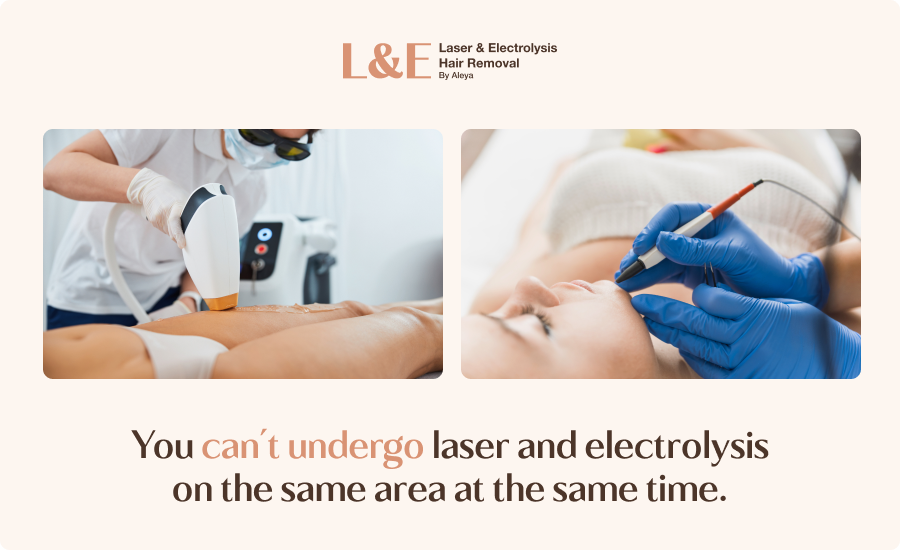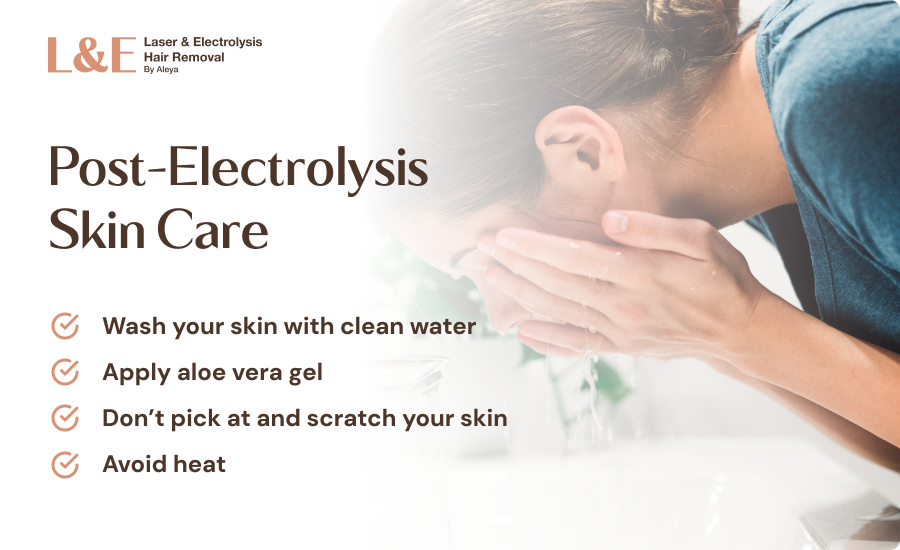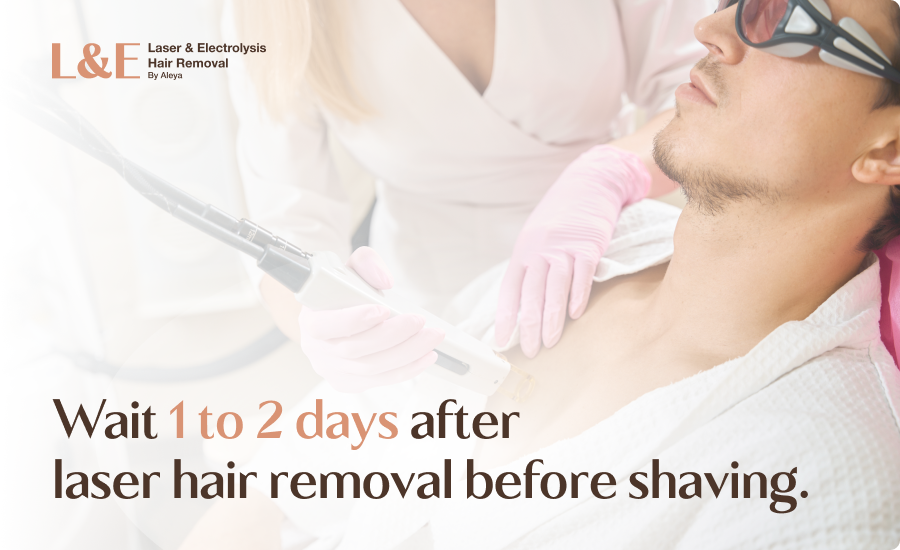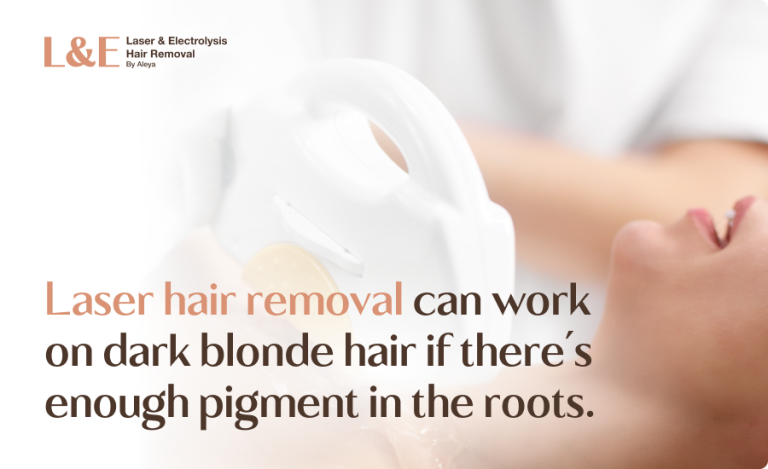Can Laser and Electrolysis Hair Removal Be Done at the Same Time?

Can Laser and Electrolysis Hair Removal Be Done at the Same Time? Key Takeaways
- No, you can’t do laser and electrolysis hair removal at the same time and area
- After you finish your laser hair removal treatments, electrolysis can help get rid of any remaining hairs
- Consulting a laser specialist ensures a safe and effective plan for combining both treatments
Undergoing electrolysis and laser hair removal simultaneously in the same area could damage the skin.
However, if you’re planning to target different hair types and treatment areas, laser and electrolysis can be done at the same time.
These two treatments work best on different hair types:
- Laser hair removal targets melanin (pigment) in the follicle, making it most effective on dark, coarse hairs
- Electrolysis is ideal for white, grey, blonde, or red hairs, which lack pigment and therefore cannot be effectively treated with laser
In this guide, we will:
- Discover when it’s safe and effective to combine laser and electrolysis treatments
- Compare laser vs. electrolysis
- Find out if (and when) you can shave after laser hair removal
- Explore expert laser and electrolysis services at Laser by Aleya, where your treatment plan is tailored just for you
Can I Get Laser and Electrolysis Treatments on the Same Day?
No, doing both on the same area during the same session can over-irritate the skin and delay healing.
Your provider will recommend spacing treatments apart by at least one to four weeks, depending on which comes first.
When Can You Combine Laser and Electrolysis Hair Removal?
Laser and electrolysis can complement each other, but not at the same time and not on the same spot back-to-back.
Most clients combine them in these two scenarios:
1. You’re Starting With a Large Area
Laser hair removal is ideal for quickly thinning out large, dark-haired areas like the legs, back, or underarms.
Once the hair becomes finer or patchier, electrolysis can step in to target the stubborn strands, especially light, gray, or red hairs that the laser can’t see.
2. You Have Mixed Hair Types or Hormonal Hair Growth
If you’re addressing facial hair caused by conditions like PCOS or hormonal imbalances, you might notice both coarse, dark hairs and finer, lighter ones.
Laser hair removal effectively targets and reduces the darker, thicker hairs.
Meanwhile, electrolysis is ideal for permanently removing finer hairs or regrowth that laser treatments might not affect.

Electrolysis vs. Laser Hair Removal
| Feature | Electrolysis | Laser Hair Removal |
| How It Works | Uses a fine probe and electric current to destroy each hair follicle individually | Uses light energy to target and damage multiple hair follicles at once |
| Hair Color Compatibility | Works on all hair colors, including gray, blonde, and red | Most effective on dark hair; less effective on light or gray hair |
| Skin Tone Compatibility | Safe for all skin tones, including dark skin | Modern lasers (like Nd:YAG or diode) work on most skin tones |
| Treatment Areas | Great for small, detailed zones (face, eyebrows, fingers) | Ideal for larger areas (legs, back, underarms) |
| Pain Level | Mild to moderate (like a zap or pinch) | Mild (like a warm rubber band snap) |
| Costs | Sessions start at $25 for 10 minutes and go up to $80 for a full 60-minute treatment | Starts at $30 for the upper lip and up to $55 per session for the bikini area |
How To Safely Time Electrolysis Hair Removal and Laser Hair Removal Sessions
Want the best of both worlds with laser and electrolysis? You can, but only if you play it smart.
Doing both treatments too close together, especially on the same area, can overstimulate the skin and hurt your skin.
General Timing Guidelines
- Laser first? Wait two to four weeks before undergoing electrolysis. This gives your skin time to heal and lets any laser-shed hairs fully release before targeting regrowth with electrolysis.
- Electrolysis first? Wait one to two weeks before your laser appointment. Electrolysis can leave tiny scabs or irritation. Give your skin time to settle before exposing it to heat from the laser.
How To Properly Care for Your Skin After Electrolysis Hair Removal
Electrolysis is safe and effective, but like any treatment, your skin needs a little TLC afterward.
Proper aftercare helps prevent irritation, speeds up healing, and keeps your results looking their best.
1. Gently Cleanse and Protect the Area
For the first 24 to 48 hours, wash the treated area with lukewarm water and a fragrance-free cleanser.
Pat dry, don’t rub, and avoid exfoliants, retinoids, or toners.
Your skin is more vulnerable during this window, so keep it clean, dry, and free from potential irritants.
2. Soothe With Targeted Aftercare
Apply aloe vera gel or alcohol-free witch hazel to calm inflammation and accelerate healing.
You can also use clean cotton or sanitized hands, and reapply up to three times a day if the area feels warm or irritated.
Tip: Store your aloe in the fridge, as cooling the skin can boost comfort and reduce swelling faster.
3. Let Your Skin Heal Naturally
It’s normal to see tiny scabs or dry patches as your follicles close and recover.
Avoid picking, scratching, or using exfoliating tools. Interfering with this healing process can cause hyperpigmentation or scarring, especially on sensitive areas like the face or bikini line.
4. Avoid Heat, Sweat, and Sun Exposure
For 48 hours, stay out of:
- The gym
- Saunas
- Hot showers
- Direct sunlight
Heat opens the follicles, which can invite bacteria and trigger breakouts or uneven pigment.
If you go outside, use mineral sunscreen (SPF 30+) and wear a wide-brimmed hat for extra protection.

Laser Hair Removal Aftercare: What Your Skin Needs Post-Treatment
Here’s what most clients swear by to speed up healing and reduce side effects after a laser hair removal session.
1. Cool the Area With Gentle Compresses
Right after your session, your skin might feel warm or slightly swollen.
Place a soft, damp washcloth or wrapped ice pack on the treated area for a few minutes at a time.
This helps calm inflammation and reduces the sunburn-like feeling many clients notice post-treatment.
2. Use Any Creams or Medications as Directed
If your provider gives you a steroid cream, apply it exactly as instructed, as it can ease discomfort and help your skin recover faster.
You can also take over-the-counter pain relievers or an anti-inflammatory if you’re feeling sore.
3. Shield Your Skin From the Sun
Laser-treated skin is extra sensitive, so avoid direct sunlight for at least a month before and after your session.
Once you’re cleared to go outdoors, apply a broad-spectrum sunscreen (SPF 30 or higher) daily, even on cloudy days.
Can You Shave After Laser Hair Removal?
Yes, you can shave after laser hair removal, but it’s best to wait 24 to 48 hours.
This gives your skin time to calm down and helps prevent irritation.
You might notice some hair regrowth between sessions, and that’s normal. Shaving during this time is completely fine and won’t interfere with your laser results.

Discover Expert Electrolysis and Laser Hair Removal Services at Laser by Aleya
Laser and electrolysis shouldn’t be done on the same area at once, but when timed right, combining them strategically can deliver incredible results (especially for stubborn or mixed hair types).
At Laser by Aleya, we specialize in both electrolysis and laser hair removal, so you don’t have to choose blindly.
We’ll guide you through a custom treatment plan that’s safe, effective, and tailored to your skin goals and preferences.
Can Laser and Electrolysis Hair Removal Be Done at the Same Time? FAQs
Does electrolysis hurt more than laser?
Electrolysis often feels slightly more intense than laser hair removal, but it depends on the area and your pain tolerance.
Facial zones like the upper lip or chin tend to be more sensitive due to thinner skin, while areas like the arms or legs are usually easier to tolerate.
Is it safe to combine laser and electrolysis over time?
Yes, many clients combine both methods for better results.
Laser is great for thinning large areas, while electrolysis can target lighter or stubborn hairs that laser might miss.
Will combining laser and electrolysis make hair removal faster?
Yes, with a smart treatment plan, combining both methods can help you reach your hair-free goals more efficiently, especially if you’re treating areas with mixed hair types.

![Top Bikini Laser Hair Removal Styles [Illustrations & FAQs]](https://www.laserbyaleya.com/wp-content/uploads/2025/06/bikini-laser-hair-removal-hero-image-updated-768x469.png)
